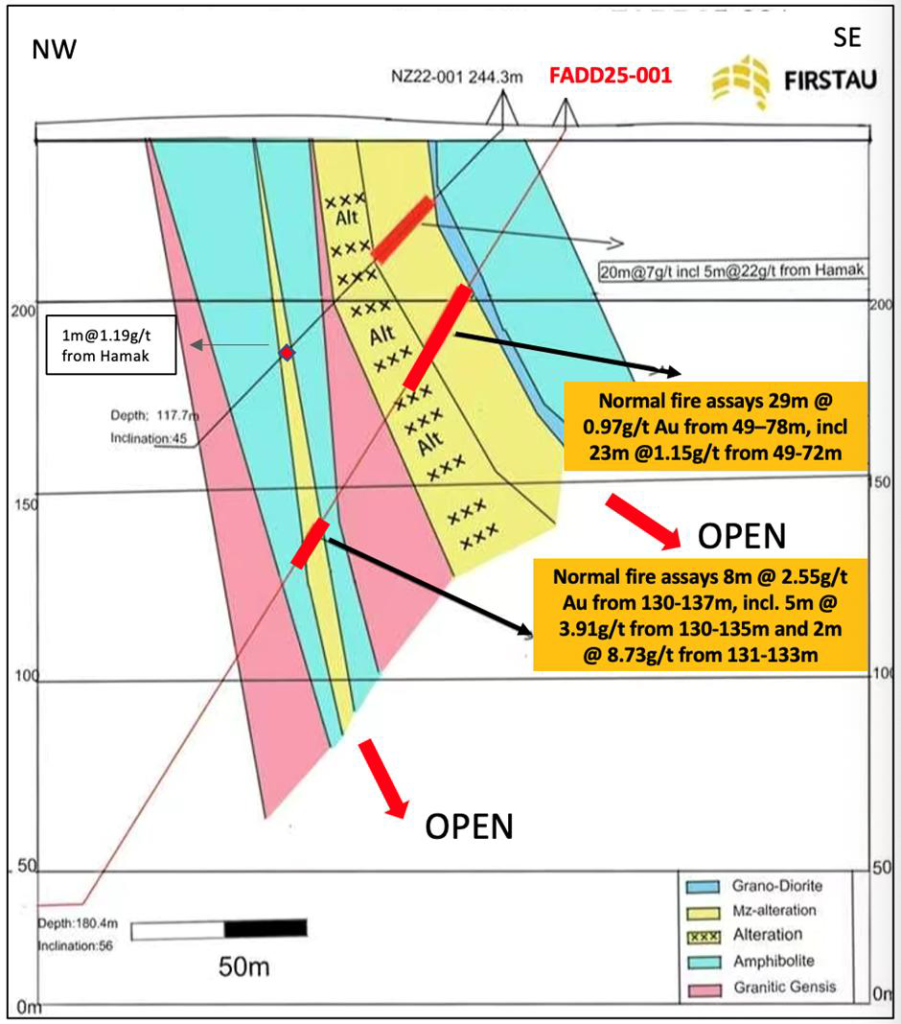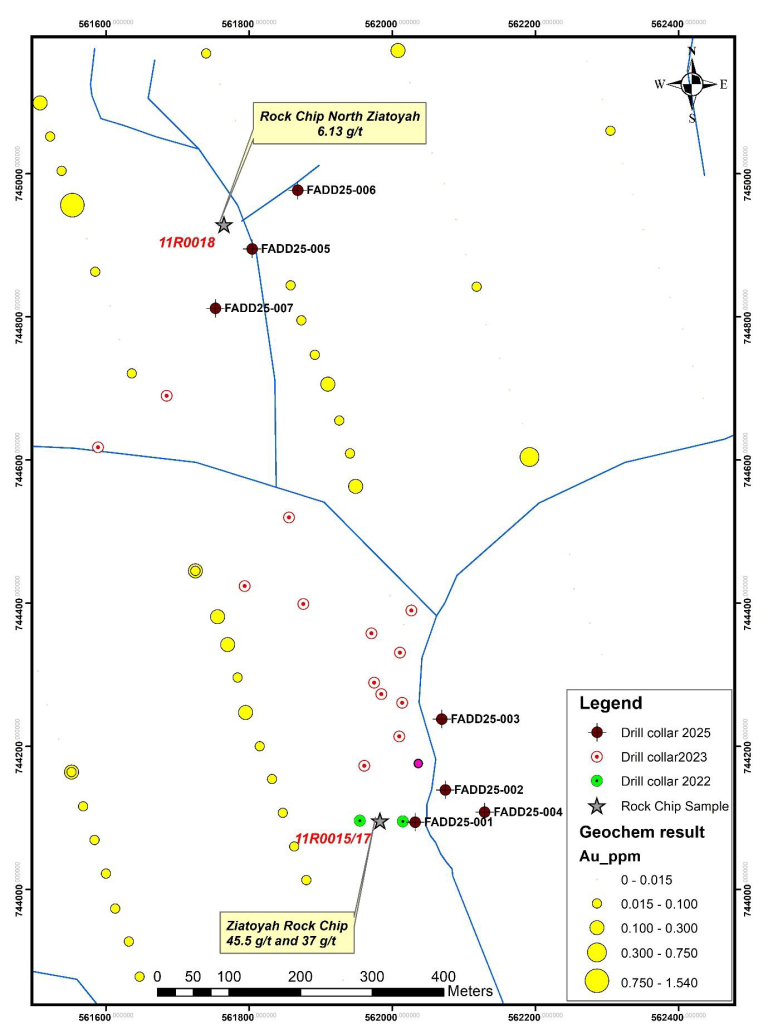Wide Gold Intersections from Nimba Drilling

Hamak Strategy Ltd. (LSE: HAMA / OTCQB: HASTF), a company combining traditional gold exploration in Africa with a Digital Asset Treasury Management strategy, is pleased to announce the first drilling results from its joint venture (JV) with First Au Limited (ASX: FAU) on its 65% owned Nimba gold project.
Highlights
- Hole FADD25-001 intersected a wide mineralised zone of 29m at 0.97g/t Au from 49m
to 78m
o Including 23m at 1.15g/t Au from 49m to 72m depth, with individual high-grade
intersections of 4.1g/t Au, 3.1g/t Au, 2.7g/t Au, 2.3g/t Au and 2.0g/t Au - A deeper intersection also yielded 8m at 2.55g/t Au from 130m to 138m
o Including 2m at 8.37g/t Au with individual intersections of 7.7g/t Au and 9.1g/t
Au - These intersections confirm the continuity of mineralisation at depth from the first
Hamak drilling that intersected 20m at 7g/t Au closer to surface - The gold mineralisation remains open at depth
- Assay results for the next two holes, FADD-002 and 003, are expected in the near
future
Nick Thurlow, Executive Chairman of Hamak Strategy, commented:
“We are greatly encouraged by the wide intersections of gold mineralisation returned
from the first hole assay results, which confirm the depth extensions to the high-grade
discovery made by Hamak. We look forward to advancing the drilling programme and
reporting further assay results, in partnership with and funded by our JV partners, First
Au Limited.”
Hamak’s joint venture partner, FAU (35% project owner), is fully funding exploration work at Nimba to include an initial 3,000m drilling programme at the Ziatoyah gold discovery. Drilling is currently ongoing with five holes for 948.90 metres, having been completed to date. The objective of the drilling to confirm the original high-grade drilling results of Hamak has been successfully achieved, and further drilling is ongoing to determine the continuity and structural control of the gold mineralisation.
The first hole drilled, FADD25-001, was oriented with the objective to prove the depth extensions of Hamak’s near-surface and high-grade intersection of 20m at 7g/t Au (hole NZ22-001). The assay results confirm a wider intersection of 29m at 0.97g/t Au, which included a higher grade zone of 23m at 1.15g/t Au. A second deeper zone returning 8m at 2.55g/t Au was also intersected, confirming the widening of a narrower zone intersected by Hamak’s drilling of 2m at 1.2g/t Au (Tables 1 and 2 and Figure 1).
Table 1: Drill Hole Information for Current Programme and Hamak Strategy’s Discovery
Hole
| Hole | Easting | Northing | Elevation (m) | Azimuth (degrees) | Inclination (degrees) | End of Hole (m) |
|---|---|---|---|---|---|---|
| FADD-001 | 562032 | 744094 | 243.26 | 293 | -50 | 240.0 |
| FADD-002 | 562074 | 744139 | 241.50 | 293 | -60 | 280.5 |
| FADD-003 | 562069 | 744238 | 240.60 | 293 | -62 | 264.5 |
| FADD-004 | 562129 | 744238 | 241.50 | 293 | -60 | 99.7 |
| FADD-005 | 561803 | 744897 | 246.17 | 305 | -55 | 102.20 |
| NZ22-001 | 562015 | 744095 | 244.30 | 292 | -45 | 117.7 |
Table 2: Significant Downhole Intercepts of FADD25-001 and NZ22-001
| Hole | From (m) | To (m) | Downhole Length (m) | Grade (g/t AU) |
|---|---|---|---|---|
| FADD-001 | 49 | 78 | 29 | 0.97 |
| including | 49 | 72 | 23 | 1.15 |
| 130 | 137 | 8 | 2.55 | |
| including | 130 | 135 | 5 | 3.91 |
| and including | 131 | 133 | 2 | 8.73 |
| NZ22-001 | 29 | 49 | 20 | 6.98 |
| including | 35 | 40 | 5 | 21.73 |
| 85 | 87 | 2 | 1.19 |
Figure 1: Section of Drilling and Mineralisation at Holes NZ22-001 and FADD25-001

A number of high-grade intersections were made in the wider mineralised zone of hole FADD-001 (Table 2) and repeat assays show variability in some results, which is indicative of coarse native gold. Visible gold was observed in both FAU’s hole FADD25-001 (Figure 2) and Hamak’s hole NZ22-001.
Figure 2: Visible gold (circled in red) captured at 51m (a), 60.95m (b) and 132m (c) from hole FADD25-001

Screen fire assays are currently underway to verify the potential presence of larger gold particles that may have been under-represented in the initial crushed pulp assays.
Drill holes FADD-002 (280.50m) and FADD-003 (264.50m) have been completed and assays are pending. Drill hole FADD-004 was abandoned at 99.7m due to ground conditions.
Holes FADD-005 (100.20m) and FADD-006 (in progress) and 007 are located some 500m to the north of the Ziatoyah discovery and are testing a new area where artisanal gold mining coincides with strong geochemical soil anomalies and a surface rock sample assay that returned a grade of 6.13g/t Au (Figure 3).
Further updates on progress will be announced in due course.
Figure 3: Drill Hole Location and Geochemical Gold in Soil Anomalies
